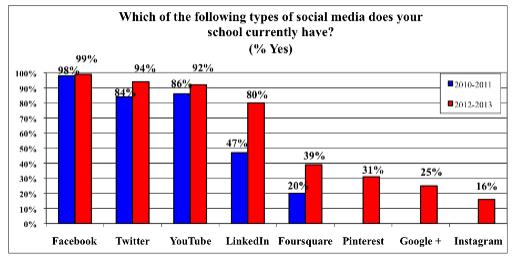In mid-August, a very interesting survey was released from University of Massachusetts Dartmouth, that was focused on “how does a college or university recruit in this new highly networked, constantly on world”. This is the 5th year of this survey, which has been collecting information on the use of social media since 2008.
Authors of the survey, Nora Ganim Barnes, director of the Center for Marketing Research at the university and Ava Lescault, interviewed managers responsible for social media efforts at schools, across the landscape of higher ed , including, public, private and for-profit, small to large, including 474 institutions in total.
Interesting enough, the aspect of the survey that has attracted the most coverage is the amount of tweeting and facebooking done by university presidents. Asking about this for the first time this year, the survey found that 58% of top administrators are facebooking and 55 % are tweeting. This topic was highlighted recently at the EduWeb conference in Boston, with an opening plenary from President Santo Ono from the University of Cincinnati about his experiences tweeting on behalf of himself, the university and the impact that it has had on recruitment. It seemed from audience reaction at the conference that this was a rather rare circumstance but the survey seems to indicate it is much more common that we all understood.
A tweeting president is a new and important component in your social media mix but I found that the meat of the survey, about the evolving trends in social media marketing channels, to be the really interesting part.
Source: Univ. of Mass. Dartmouth Survey (see link above)
The survey suggests that the big three continue to grow in use by higher ed marketers. LinkedIn had the most dramatic growth, almost doubling in use from 47% to 80 %. And this stat was determined before general knowledge of the recently announced LinkedIn University pages, which will likely increase the use of LinkedIn even more dramatically. Pinterest, Google+ and Instagram, measured for the first time this year, also have strong and growing bases of use.
So how is this being funded, you ask. Well, the survey indicates that needed budget is being taken away from traditional offline activities, but frankly it’s surprising to me how little these have decreased. I think this indicates two things. One, higher ed marketers are very reluctant to turn off the taps to traditional advertising for fear of losing hard fought ground and two, they continue to experiment with social media channels, generally for free, with minimal investment made, until they can confirm their actual effectiveness and ROI and they then invest (usually in people to manage it) .
 Source: Univ. of Mass. Dartmouth Survey (see link above)
Source: Univ. of Mass. Dartmouth Survey (see link above)
Another very interesting piece of information revealed by the survey was about the use of social media listening. The use of social media listening has actually decreased quite dramatically over the last few years, down from 73% in 2009 to 38% in 2013.
Source: Univ. of Mass. Dartmouth Survey (see link above)
This stat seems rather odd to me, (unless the question was misunderstood), given the expanding use of social media channels across the board. The only reason I can guess that this might be the case is that because the people managing these channels are so maxed out, especially given that most colleges are pushing more content to more channels, that they actually have less time and energy to monitor the results of their activities and actually listen to the interactions on the channels themselves. Consistent with this is one other survey stat, that reported that half of schools still don’t have guidelines for acceptable online student behavior. Strange, given how sensitive most schools are to the risk of social media being used to criticize their institutions and then not being able to control it. This is a very dangerous tipping point, as the quality of content on any given social media channel is directly related to your listening to the channel and interacting effectively with it.
Is this a worn out ostrich with its head in the sand effect, with marketers having neither the time nor the will to closely monitor and deal with what they find on social media? Hard to imagine that this is the case but only time will tell.
What do you think?.







